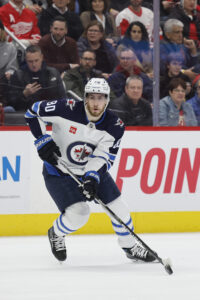Last season was a tough one for Anaheim in the standings. With the team squarely in a rebuild, they struggled considerably at both ends of the ice, allowing the most goals in the league while scoring the second-fewest. That resulted in head coach Dallas Eakins being let go with Greg Cronin, a long-time coach at lower levels, getting his first opportunity to run an NHL bench. However, based on what has been a quiet summer, expectations for 2023-24 should be similar to how last season went as this is a team that remains in transition.
Draft
1-2: F Leo Carlsson, Orebro (SHL)
2-33: F Nico Myatovic, Seattle (WHL)
2-59: F Carey Terrance, Erie (OHL)
2-60: G Damian Clara, Farjestad (Sweden U20)
3-65: F Coulson Pitre, Flint (OHL)
3-85: F Yegor Sidorov, Saskatoon (WHL)
4-97: D Konnor Smith, Peterborough (OHL)
5-129: D Rodwin Dionicio, Windsor (OHL)
6-161: D Vojtech Port, Edmonton (WHL)
While Anaheim finished last in the league, they weren’t able to win the lottery for the top pick, sliding to second. GM Pat Verbeek then surprised some with the selection of Carlsson over the consensus second choice (Adam Fantilli). Carlsson gives the Ducks a third center with early first-round pedigree and the hope is that he along with Trevor Zegras and Mason McTavish will allow them to eventually be a dominant team down the middle. Carlsson has already signed his entry-level deal but could be loaned to the AHL or back to the SHL if he doesn’t crack the roster.
Myatovic was a bit of a surprise selection as the top pick on the second day of the draft but he rose up draft boards all season long and should be in line for a much bigger role with the Thunderbirds this coming season. Terrance tripled his goal total from his rookie OHL season to become one of the better draft-eligible scorers in that league while finishing strong at the World Under-18s. Clara also was picked well before his consensus rankings but was one of the tallest goalies in this draft class. Anaheim hopes the Italian netminder will one day push for NHL playing time but is a longer-term project.
Trade Acquisitions
F Andrew Agozzino (San Jose)
D Ilya Lyubushkin (Buffalo)
Agozzino was acquired the day before the draft in a swap of veterans that spent most of last season in the minors. The 32-year-old was productive in limited NHL duty last season, recording three points in four games while averaging nearly a point per game in 63 AHL contests. Agozzino will get a chance to crack Anaheim’s roster in training camp but is likely ticketed for AHL San Diego.
Lyubushkin was recently acquired from Buffalo for a fourth-round pick. The 29-year-old will bring some physicality to their third pairing and with him being on an expiring contract, he becomes a strong candidate to be flipped at the trade deadline with some salary retention.
UFA Signings
D Trevor Carrick (one year, $775K)*
D Radko Gudas (three years, $12MM)
D Robert Hagg (one year, $775K)
F Alex Killorn (four years, $25MM)
G Alex Stalock (one year, $800K)
*-denotes two-way contract
 Killorn’s AAV wound up being the most expensive of any forward in this UFA class, a distinction few would have expected heading into the open market. He also received a full no-trade clause in the first two seasons of the deal plus a partial no-trade in the final two years. For a player best utilized as a second-line winger, it’s definitely an overpayment from Anaheim’s perspective but it’s clear that Verbeek is placing a high level of importance on what he also brings off the ice to help what is a very young core. The 33-year-old is coming off his two best seasons offensively and has hit the 25-goal mark in three of the last four years. It will be interesting to see how close he can get to that going from one of the strongest offensive teams to one of the weakest.
Killorn’s AAV wound up being the most expensive of any forward in this UFA class, a distinction few would have expected heading into the open market. He also received a full no-trade clause in the first two seasons of the deal plus a partial no-trade in the final two years. For a player best utilized as a second-line winger, it’s definitely an overpayment from Anaheim’s perspective but it’s clear that Verbeek is placing a high level of importance on what he also brings off the ice to help what is a very young core. The 33-year-old is coming off his two best seasons offensively and has hit the 25-goal mark in three of the last four years. It will be interesting to see how close he can get to that going from one of the strongest offensive teams to one of the weakest.
Gudas certainly bolstered his value with a good playoff showing for Florida in their run to the Stanley Cup Final, providing plenty of snarl and physicality on the third pairing. He’ll likely be asked a more prominent role with Anaheim with many of their strong blueline prospects still a year or two away from making a serious push for playing time. Hagg is best known for, you guessed it, his physicality on the back end. Injuries limited him last season in Detroit and he’ll be trying to lock down a regular spot on the blueline to help rebuild some value. Carrick is a strong offensive blueliner at the AHL level and should be a key piece for San Diego next season. The move reunites him with his brother Sam who played in 52 games for the Ducks last season.
Stalock was one of the feel-good stories in the NHL in 2022-23. Battling through myocarditis the previous two years, the veteran had only made one NHL appearance in those two campaigns combined. He wound up making 27 appearances in Chicago, posting a .908 SV% that was above the league average despite being on a rebuilding team that had only one more point than the Ducks in the standings. He’ll battle prospect Lukas Dostal for the second-string position between the pipes.
RFA Re-Signings
G Lukas Dostal (two years, $1.625MM)*
F Benoit-Olivier Groulx (one year, $775K)*
F Troy Terry (seven years, $49MM)
*-denotes two-way contract
 Terry is an example of how a bridge contract can work out well for a player in the end. It took him a while to make an impact in the NHL which led to his second contract being a three-year bridge. In the second season of that deal, his production took off as he recorded 67 points and then followed it up with a 61-point showing last season despite missing a dozen games. In doing so, he showed that he is a capable top-line weapon for the Ducks and he should be a focal part of the attack for years to come to work with their young middlemen. This deal took until just before a scheduled arbitration hearing to get done where the two sides were well apart in their filings but it should work out well for both sides.
Terry is an example of how a bridge contract can work out well for a player in the end. It took him a while to make an impact in the NHL which led to his second contract being a three-year bridge. In the second season of that deal, his production took off as he recorded 67 points and then followed it up with a 61-point showing last season despite missing a dozen games. In doing so, he showed that he is a capable top-line weapon for the Ducks and he should be a focal part of the attack for years to come to work with their young middlemen. This deal took until just before a scheduled arbitration hearing to get done where the two sides were well apart in their filings but it should work out well for both sides.
Groulx has seen NHL action in each of the last two seasons, totaling 20 appearances. He will be waiver-eligible for the first time this fall and isn’t a lock to get through unclaimed. The long-term Achilles injury to Isac Lundestrom could open up a spot for him to break camp with Anaheim if he has a strong training camp.
Dostal held his own in 19 appearances with the Ducks last season but took a bit of a step back with the Gulls in the minors, seeing his GAA go up from 2.60 to 2.97 while losing four points off his save percentage (to .912). Even so, he’s viewed as a possible goalie of the future for Anaheim and so even with Stalock in the fold, it’s likely that Dostal will see at least some NHL action this season.
Departures
D Nathan Beaulieu (unsigned UFA)
D Simon Benoit (unsigned UFA)
F Max Comtois (unsigned UFA)
F Derek Grant (Zurich, NLA)
D Scott Harrington (unsigned UFA)
F Justin Kirkland (Arizona, one year, $775K)*
F Jayson Megna (Boston, one year, $775K)*
D John Moore (unsigned UFA)
D Chase Priskie (Washington, one year, $775K)*
D Kevin Shattenkirk (Boston, one year, $1.05MM)
F Josiah Slavin (Toronto, AHL)
G Anthony Stolarz (Florida, one year, $1.1MM)
D Andrej Sustr (trade with San Jose)
Up front, Comtois is the most notable loss. A couple of years ago, he looked like a middle-six fixture of the future but struggled considerably since then resulting in a mutual non-tender. Grant has had three stints with the Ducks and had a career year in 2021-22 but was limited to just five goals in 48 games last season. Rather than seek a PTO, he decided to try his hand overseas where he’ll have a more offensive role. Megna played in 55 NHL games last season between Colorado and Anaheim in a fourth-line role that can be replaced from within while Kirkland and Slavin were regulars with the Gulls.
There has been considerably more turnover on the back end. Shattenkirk was second on the Ducks in points by a defender last season, a role that isn’t going to be filled from their external acquisitions. RFA Jamie Drysdale, on the other hand, seems poised to assume that role. Benoit very quietly logged over 19 minutes a night on the back end and held his own, making him one of the more intriguing options left on a thinned-out UFA market.
Beaulieu was supposed to be a blueliner with some upside when he came into the league but has seen his production crater in recent years; he hasn’t scored a goal in the last three seasons. He’ll likely need to go the PTO route to have a shot at making a roster in October. Harrington is in a similar situation. He has been a seventh defender in recent seasons and is serviceable in that role but it’s not one that will have teams offering up guaranteed money at this point of the summer. Sustr and Priskie were AHL regulars last season while Moore missed the entire season dealing with lingering concussion symptoms.
Stolarz battled injury trouble last season, costing him 39 games in total and perhaps a shot at landing a likelier backup spot along the way. He struggled in 2022-23 with a save percentage of just .874 in 19 games but in his first three seasons with Anaheim, he had a .920 mark in 37 contests. He’ll battle for the number two role in Florida but is likely ticketed to be a high-paid insurance option in the minors.
Salary Cap Outlook
Few teams have as much cap space as the Ducks do as they have roughly $16.6MM in flexibility, per CapFriendly. That number will certainly go down once Zegras and Drysdale – their two remaining restricted free agents – sign new contracts but Anaheim has ample cap space at their disposal both for the upcoming season and the foreseeable future.
Key Questions
 To Bridge Or Not To Bridge: Zegras has been a productive center over the last two seasons, notching 23 goals in both campaigns while improving his point total from 61 to 65 in 2022-23. The market for these types of players is well-defined; a max-term contract should cost somewhere around the $8MM mark which would move him ahead of Terry. Is that a price tag Verbeek is willing to pay or would he prefer to see if Zegras has another gear he can get to first? A bridge contract should be more in the $5MM range but could push his next contract into the $10MM range if he has another level to get to offensively. Verbeek has suggested that if Carlsson is able to make the team at center, it could be Zegras who is shifted to the wing which could also affect his value moving forward.
To Bridge Or Not To Bridge: Zegras has been a productive center over the last two seasons, notching 23 goals in both campaigns while improving his point total from 61 to 65 in 2022-23. The market for these types of players is well-defined; a max-term contract should cost somewhere around the $8MM mark which would move him ahead of Terry. Is that a price tag Verbeek is willing to pay or would he prefer to see if Zegras has another gear he can get to first? A bridge contract should be more in the $5MM range but could push his next contract into the $10MM range if he has another level to get to offensively. Verbeek has suggested that if Carlsson is able to make the team at center, it could be Zegras who is shifted to the wing which could also affect his value moving forward.
Will Gibson Move? There has been no shortage of trade speculation involving veteran goaltender John Gibson this summer. It got to the point where there were reports of a trade demand although those have been denied. That said, it wouldn’t be shocking if the 30-year-old would want a change of scenery as he’s under contract for four more years and let’s face it, the Ducks aren’t exactly close to challenging for a playoff spot. A $6.4MM cap charge will make getting commensurate value very difficult in this marketplace but if a team runs into goalie trouble early in the year, Gibson could be an intriguing target.
Defensive Youth Movement? There are definitely some placeholders on Anaheim’s back end right now as only Cam Fowler and Radko Gudas are signed for more than one year with Drysdale likely to add to that list (even on a bridge contract). Meanwhile, the Ducks are loaded in defensive prospects with the top rearguards in the WHL (Olen Zellweger), OHL (Pavel Mintyukov), and QMJHL (Tristan Luneau) with Jackson LaCombe and Drew Helleson already having gotten their feet wet at the NHL level. Zellweger and Mintyukov can start their pro careers this season with the Gulls and if they can push for playing time quickly along with LaCombe and Helleson, the blueline that ends the season could look a whole lot different than the one that starts the year while giving the team (and fans) a glimpse of what’s to come.
Photos courtesy of USA Today Sports Images.


